22 June - 7 July 2006
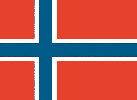
| Norway: 22 June - 7 July 2006 | 
|
One parent and all her children planned this trip, seeing it as the only chance to do such a thing: leave everyone behind, spouses and children, and attempt to gain some insight into our singular heritage in each other’s presence. The mission was simple enough: the kids would research both our father’s and our mother’s ancestry while meeting distant cousins on both sides; mother, Faye, would contact those family members and friends she’d met on her three previous trips, while continuing her own genealogy research.
Without having known in advance that we could really pull it off, (or that we would ever speak to each other afterward) we now happily claim the selfish pleasure that we will always attach to it.
We did it, and it’s something we can share with everyone else who needs, or wishes, to go home to Norway.
If you'd like to follow along in the story of the family, you can view a chart of just five generations.
The purpose of our trip was to visit the birthplaces of the seven great-grandparents displayed in green on this chart.
Thursday-Friday, June 22-23
Four family members from four different cities had managed to rendezvous at Newark for the non-stop flight to Norway, the land of our ancestors––all of our ancestors. Having played smear (a card game we learned as children in Minnesota) and grabbed all the free stuff we could from the Continental Airlines President’s Club, we’d slept and fretted the normal amount as we flew over the Atlantic.
Landing at Oslo Gardemoen Airport at 9:30am, our Norway trip was begun in earnest. We checked our luggage through to our first destination––Tromsø, a small city that lies more than two hundred miles above the Arctic Circle. During a planned, four-hour layover we had time for another few hands of smear and Kamin bought a ten-dollar sandwich (welcome to Norway!) before we took off at 2:30pm.
Jørgen and Ann Harieth Nerdal––relations on the Wiken (maternal grandmother) side of our family––met us at the Tromsø airport. They live about an hour south of there, and Marisa had mentioned them to our family at Seljehaug in Målselv––yet another hour south––and since then they’d been speaking with each other and planning our stay. A series of pleasant, family hospitality events––which would last for fifteen days––was under way!
Faye rode with our hosts, and Kamin took the wheel of our rental car to follow Jørgen and his silver BMW to his son Ivar’s house to meet him, his wife and their two youngest children. We stayed but a few minutes so as to make our brand new dinner dates on time. We were pleasantly surprised to learn that the celebration of Midsommer takes place not on the longest day of the year (the day before, 21 June), but on the 23rd, the day of our arrival.
We drove south, around the fjord, to the Nerdal home in Storsteinnes. Ann offered a snack of lefse (think of it as a large potato tortilla!), butter, and a creamy, raisin-y topping. We enjoyed their beautiful house and garden, but had to run to our 8:00 dinner at Seljehaug.
Further south we went, and in minutes we landed among the many houses of the Seljehaug farm, in the Målselv district of the Troms fylke (county). This is the birthplace of our great-grandmother, Lorentina Regina or simply, Gina. She’s our father’s mother’s mother (easier said in Scandinavian countries as farmormor, where far=father and mor=mother). She and her daughter, along with the rest of her siblings and parents, emigrated to North Dakota in the early years of the twentieth century. We had only recently discovered that we had family who still live on this property and had been emailing madly back and forth for three months.
As we turned into the driveway, Marisa spotted Yvonne, holding her son, Ole Marius, on the deck of the main house. Her husband, Ole, greeted us, along with Yvonne's parents, Ole Kristian and Frøydis, and grandmother (bestemor) Solveig who all stepped out to shake hands. (This would not be the first time that multiple “Oles” will be present at one time!) Nearly all speak wonderful English, better than our halting, American excuse for Norwegian.
It was chilly outside though the sun had finally broken through the clouds. The farm is beautifully situated near its own trout fishing lake (where they used to take their clothes to wash by hand, says Frøydis). Tall, snow-capped mountains surround the place; Seljehaug itself is on a small hill or knoll (selje = a kind of tree; haug = knoll). It turns out that a bit of their research in preparation for our arrival determined that some of our earliest known family members had once lived further up one of these hillsides.
We sat down to a true feast: reindeer with cream sauce is served over rice along with a sauce of red berries: tyttebær. (The English translation for these is “cowberries.” Yes, you read that right.) Next was bread with spekkekjøtt, a dried and cured lamb that looks much like prosciutto. Rommegrøt is served as a traditional part of the Midsommer feast, accompanied by melted butter, sugar, cinnamon, and raisins. (This is very much like the milk mush we Minnesotans all had as children, but much fancier, made with sour cream.) Beer, juice, anything we wanted.
Dessert? There’s more? A large meringue and cream concoction was walked to the table and served with bottomless cups of good norsk coffee.
We had created a little booklet of genealogy information along with some old photographs for this family. They passed this around, while we got to savor old photographs in their family albums. Lots of conversation around two tables and we were all up until midnight. Ole Kristian played his Hammond organ for us (originally from Bergen, he once played “for money,” as he says.) Fighting through a touch of arthritis, he played wonderfully.
Faye and Marisa got their European cell phones up and running, leaving messages at home. Finally to bed at 12:15am. The sun was still so bright that Kamin read his book without the lamp. That is, he read half a page before falling fast asleep.
Saturday, June 24
Marisa awoke before the others at 8:00am to grab her first shower in two days. Ole Kristian went off to work at Gullsmed Barnung, their jewelry (gullsmed = goldsmith) store in Bardufoss just ten minutes away. Frøydis had given herself the day off and began to bring out items for our frokost (breakfast): smoked salmon, hard boiled eggs, tomatoes, a kjøttrull med lam (a northern norsk specialty: meatroll with lamb), three kinds of cheese, Solveig’s homemade bread, salami and butter and, of course, the first of three pots of coffee.
We enjoyed Frøydis immensely and noted that her English improved with every passing hour. She recalled that ten or twenty years before, this northern area of Norway was considered of military importance to both Norwegians and NATO forces. It was thought that the area around Tromsø would be the first defensive line in any Soviet invasion over the northern border with Norway. She remembers the American soldiers who would be there conducting exercises with the Norwegian forces. Many times, these Americans would drop by the store and she’d get to practice her English. Now, however, they don’t go fishing on one of the mountain lakes just outside the window because the Norwegian military have left some unexploded land mines up there.
Damita and Faye were awakened at 9:00am and soon joined what would become a two-hour meal at the big table. Yvonne and Ole Marius arrived at 11:00 and all made plans to drive to Bardufoss.Gullsmed Barnung is on the second floor of a two-story mall along with a supermarket, electronic store and hair salon. Ole Kristian greeted us from behind the register. Soon Ole Marius and Yvonne retreated to the back office where the little one promptly fell asleep on the desk. Just like a kid who plays outside in the Minnesota mid-summer, he was covered in mygg (mosquito) bites, poor thing. He was impeccably behaved, however: no scratching, no whining, no crying. We saw him for hours every day of our visit and, though he looked a bit puzzled as we continued to speak English, he didn’t pout or whine for attention. (We remembered a little boy pitching a fit at the airport, so we didn’t chalk up Ole Marius’ stellar behavior as a cultural phenomenon; he’s just a good guy.)
We browsed through the store until 2:45pm, fifteen minutes before closing. We bought many items of pewter (Frøydis says it’s better than the silver plate) that are made in Norway: Christmas presents, gifts for family members back home and, of course, a number of things just for ourselves. Our receipts revealed later on that we got a lovely family discount. Frøydis then handed each of us a pewter keychain that we had been eyeing and as we turned our gaze to the silver spoons with the Målselv crest on them, she let us know that we would also receive those as a gift!
We left Bardufoss to go to Målselvfoss, voted Norway’s national waterfall in 2003 (foss = waterfall). We met up with Jørgen and Ann Harieth in the parking lot and all walked behind the tourist center and restaurant down to the falls where we were greeted by a breathtaking sight as the clouds parted for the sun once more. Jørgen paid the thirty kroner admission price for each of us to view the salmon underwater and to get a bit closer to the falls. At regular intervals, they open a door from the salmon “ladder” or “steps” built in 1910 on the side of the falls. As soon as a salmon gets in to this side box, they shut the door again. We stared through an acrylic window at this big guy––at least thirty inches long. Other visitors were there, enjoying picnics on the tables near the top of the falls. We took several pictures and wandered slowly back to our convoy of cars.
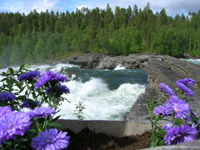
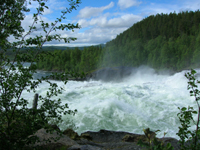
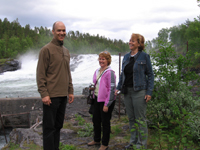
Målselvfoss Kamin, Damita, Marisa 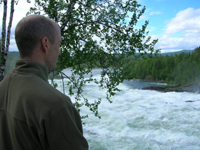

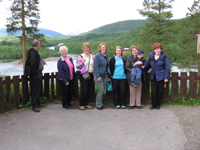
Kamin Yvonne and Ole Marius Everyone
Then, off to Fossmotunet: a collection of old buildings gathered on this site as a folk museum. Jørgen managed to beat us all to the window again and paid for our passage. Trond Arve Tobiassen, another distant cousin of this family, suddenly appeared. He had driven nine hours from his home south of here in Bodø just to surprise us. Marisa is especially pleased to see him as they (and his brother, Fred) had been corresponding via email for a couple of months, trading family history information. Both Trond Arve and Fred had been invaluable in tracking down details of our emigrating family. They had been interested in their genealogy puzzles for some time and had written Solveig several months before, asking for information and offering some of their own. Since we had just made contact with Solveig’s family, the timing was perfect!
We entered an old house, opened by the teenage attendant with a six-inch skeleton key. These are mostly nineteenth-century buildings, but furnished with all the appropriate things. Upstairs, via a very steep wooden circular staircase, is the “women’s collection” of textiles. Outside, a stabbur (a traditional Norwegian storage shed) contains butter churns, a twentieth-century cream separator (very familiar to Faye), and a variety of tools for grinding grain. A blacksmith’s shop (sma) and a barn are next. Our excited conversations overlapped among this family group of eleven people. Finally, we entered the schoolhouse that is the newest building, dating from 1899.
We were surprised to see that it was already 5:00pm. Having had no lunch, we were just now beginning to feel hungry after our large breakfast. Faye rode back with Jørgen and Ann Harieth to visit his nearby office while the rest of us rode to a bridge on the Målselva river from where we saw Bugten, the birthplace of our farmormormor (getting the hang of it?). Her name was Ana Dortea and she married Ole Ingebrigtsen from across the river. All of us on the bridge realize that we share these same great great great grandparents.
At the entrance to the bridge and across the road is a stone memorial. Yvonne told us they all stop here during their Syttende Mai procession. (The 17th of May is Norway's Constitution Day.) Just up the hill is the red house where King Haakon spent the night before escaping to England in 1940 after the German invasion, along with a newer statue symbolizing the “First Woman of Målselv” and the hard work these women have always done.
We returned to Seljehaug where another couple joined us for dinner. The husband is Vidkun, the “second man” of the town, who has also contributed to the area’s Bygdebok. Trond Arve pulled out his laptop, and we looked over his most recent discoveries about the family’s history, including material he and his brother had gleaned by poring over microfilms and handwritten parish records. This is something that we simply can’t do from our side of the ocean.
We were then called to a dinner of mutton and potato stew, more reindeer, rommegrøt, and spekkekjøtt. Solveig’s cousin Ingeborg arrived with her granddaughter. Ingeborg is a very young 86-year-old widow who listened intently as her granddaughter from Oslo translated conversation. Solveig had made another dessert, this time a large cake with strawberry filling, covered in whipped cream, and topped with gum drops. (Ole Marius happily accepts some of our gum drops.)
Hours of conversation in both Norwegian and English ensued. People moved from table to living room and back again, while coffee poured freely. At 11:30pm, only those who would stay here at Seljehaug remained. The last to bed were Faye, Frøydis, Ole Kristian, and Trond Arve, all still talking until 1:30am.
Sunday, June 25
Marisa was up first again, followed soon by Kamin, and they met Frøydis in the kitchen to help lay out breakfast. Kamin boiled the eggs and made the first pot of coffee; Trond Arve had already awakened and was up at Solveig’s house.
The remaining children of Ole Kristian and Frøydis were to join us for Sunday dinner. But first we picked up daughter Cecilie, her partner Pål, and baby Casper at the Bardufoss airport. Cecilie was the original email correspondent when we discovered this family back in April, so we were eager for face-to-face conversation. After packing their over-weight luggage in a couple of cars, they headed back to Seljehaug to their own house, and the rest of us headed to the local church.
The building that our great grandparents would have known burned several years before, and a new modernist structure stands in its place. Our farmormorfar, Ole Ingebrigtsen, is buried here somewhere. His headstone had most likely been made of wood and has long since disappeared. We know about where he should be in the older section, possibly near the other family stones. The air was humid and the mygg were thick.
After nearly an hour in this historic place, we traveled to Navaren Ydre, a farm that our great great grandfather purchased after leaving Seljehaug where his older brother and family would remain. It is a beautiful spot on the Aursfjord, the northernmost point on the road that follows the western side of this fjord. The owner, Tanya, said her 94-year-old aunt was born on the place and that she remembers an older American who visited about ten years ago. (It is too bad that she couldn't then tell him about his family still living at Seljehaug.) We walked around the property and admired the small red building that has been preserved from those days long ago when our old family left. It is strange to think that someone felt it necessary to leave such a beautiful place for the plains of North Dakota.
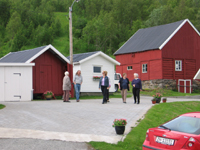
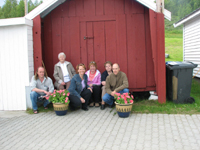
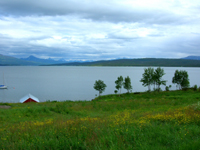
Navaren Ydre Family The View
It was nearly 4:30pm now and time to go back for turkey dinner. Tom Henning (their son), his wife and two girls had driven over from Bardufoss, and the house was overflowing with family as we sat down to another sumptuous spread. Trond Arve and Marisa spent more time with his laptop, looking at more old records and making plans to find even more and to stay in touch after returning to their homes. He left to drive through the night, back to Bodø, and get up early. It was so good to see him and we were most grateful for his family knowledge. We vowed to encourage his enthusiasm about the treasure hunt that this genealogy research has become.
After dinner, we traded gifts among family members. Trond Arve got a copy of a Minnesota photography book, different from the one we left with the Barnungs at the same time. Frøydis and Ole Kristian bought us a copy of a large Norwegian atlas, so detailed that even houses are shown on the close-up maps. We stepped outside to take a final family picture, all the time wishing we didn't have to say goodbye so soon.
We made one more side trip before going to Storsteinnes for our last night in Troms: with Solveig, Ole Kristian, and Frøydis we went to Perhansanes where our farmormormor was born and lived before she married Eliseus Olson from Seljehaug. It is just south of Navaren Ydre on the Aursfjord, but there is no drivable road between them. We stopped at an historic sawmill, the Aursfjordsaga, still in use during special events, then returned to the Nerdals for dinner.
We sat down to a lovely meal of salmon, green salad, cucumbers, potatoes with romme (sour cream), and white wine, with ice cream, strawberries, and moltebær (cloudberries) for dessert. Coffee was still being poured at 11:30pm, and, still excited by the proximity to newfound family, nobody was ready for sleep. Conversation was lively, as we’d come to expect, and Marisa tried to pick up more Norwegian, though just a few phrases here and there. Our Målselv family then departed, amid hearty hugs and promises to meet again.
We spent another few minutes in front of the large and sunny (yes, at 12:30am) window and went to bed preparing our brains and bodies for the 6:30am departure.
Sunday, June 26
Up in the wee hours of the bright morning after only a few hours of sleep, we began to feel the effects of the jet lag and the relentless daylight, a fact made more oppressive as the adrenalin rush of just being in Norway began to wear off. Ann Harieth and Jørgen were still asleep after a late night of washing dishes and cleaning up, so we left a note before getting into the car for a rainy ride to the Tromsø airport.
(Feel free to skip over the next few paragraphs about the joys of last-minute travel crises that are out of the traveler’s control. If you want to prepare yourself for the sort of screw-up that happens at least once on every trip lasting more than a week, read on. )
We arrived in plenty of time to make our early morning flight to Trondheim… except that it wasn’t listed on the departure board. SAS Braathens had canceled our flight with no warning. Puzzled looks and hushed conversation between the two SAS agents confirmed that our flight “doesn’t exist.” They then booked us on a flight leaving for Oslo and another leg back up to Trondheim.
Big mistake. We raced to the gate to discover the plane to Oslo had “technical difficulties.” (This phrase is a rather common, though vague, explanation for other flights that are canceled or delayed.) It had only been five minutes since the agents booked us on this flight. How could they not know it wasn’t going anywhere?
We were sent back downstairs to an hour-long line to rebook tickets. Of course, the first flight to Trondheim at 11:00am was full, so we got on the 2:00pm flight. Meal vouchers at 150 kroner each came in handy as we had breakfast, then “dessert” at the ubiquitous Irish pub: this one called Katie O’Connor’s. Happily, they took our vouchers for beer and wine and food, so we sat down at a wooden table and calmed our nerves with a few rounds of smear before catching the plane.
We arrived in Trondheim at 4:30pm, about five hours late. Having already called to our next family stop near Sunndalsøra to warn them of our late arrival, we drove our new rental car under breaking clouds, down to the Nerdal farm in Ålvundeid. Arriving about 8:00pm, we were to stay at Nybö, the childhood home (now guest house) of Jørgen Nerdal. It is quite close to the Nerdal farm––where we were now late for dinner!
The Nerdal family is related to our mormorfar, Halvor Wiken, who emigrated as a young boy with the rest of his family from these western fjords in the late nineteenth century. Brit’s son, Jørgen Singsdal, and his eleven-year-old son, Thorfinn, met us at Nybö. We quickly dropped off our bags and headed to the Nerdal farm. Brit greeted us with smiles and hugs. (Only Damita and Kamin were strangers to her as Faye and Marisa had met her at her home on past trips; Faye had entertained Brit when she had traveled to the U.S. Midwest a few years before.) Her husband, Harald, and her daughter, Gunlaug, were there, along with daughter-in-law, Merethe, and her other two children: Ingeborg and Martin.
During a lovely meal at their long table––roast beef, pork, sausages, potatoes, cauliflower, carrots––then waffles, strawberries, and cream for dessert, Thorfinn paged through his norsk-engelsk ordbook (dictionary), decoding particularly tricky words for all of us. These children spoke English very well and translated some for all of us. Since last Marisa and Faye had seen Brit, she had been practicing her English. Somewhat humbled by her cousin’s efforts in English, Faye promised to do better in her future studies of Norwegian.
Brit led the family in singing a table grace in Norwegian, both before and after the meal. It is the same tune that we grew up singing at St. Pauli Lutheran Church in Thief River Falls, Minnesota, so this is familiar family territory yet again.Føre maten (before the meal):
Gud signe maten på vårt bord,
Og mette kvar in mum på jord.
Gud signe oss med Faderhand
Gud signe heim og folk og land.Etter maten (after the meal):
We didn’t finish coffee and dessert until midnight, though we imagined that the sky was a bit darker than it was several hundred miles north, in Tromsø. We drive back to Nybö and fall asleep rapidly. Tomorrow we have nothing scheduled in the morning, so we may finally have a full “night’s” sleep.I Jesu navn så har vi att.
Av dine gaver vart vi mett.
Deg Gud til are, oss til gavn
Så fikk vi mat i Jesu navn.
Tuesday, June 27
Each under a luxurious dyne (comforter), we had a restful night, the earliest of us not arising until 10:30am. With nothing scheduled until 6:30pm, we enjoyed coffee in the living room and talked until noon. Damita treated herself to a Diet Coke, while Faye and Kamin had a lunch of treats purchased the day before at the Coop grocery store on the way from Trondheim: bread, cured meat, cheese, and tomatoes.
After lunch, Faye, Damita and Kamin left Nybö for Storviken. Marisa stayed behind for the solitude (and the laundry chores) and because she’d been there two years before. The drive goes back through Sunndalsøra, then up the other side of the Sunndalfjord to Storviken with a right turn off the small road and down a smaller gravel road to the farm itself. Unfortunately, the bomgang (gate) had the road closed off, which meant we had to walk the majority of the way. Kamin noted how many buildings remain along with the waterfall and grist mill. Damita remarked on the size of the large house and how old so many buildings are in Norway. The clouds were very low, so the magnificent scenery is not easy to see. We trudged back up the steep road which wasn’t as bad as Faye remembered it was when she made the same trek back in 2000.
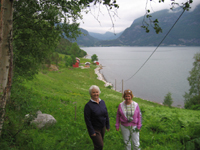
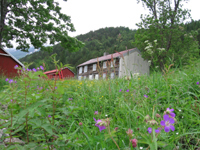
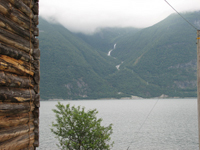
Faye and Damita Storviken The View
We now made a stop at the shopping center in Sunndalsøra to buy some more cold cuts, sardines, a cheese slicer, and four liters of Diet Coke to get Damita through these coffee-filled days. A local konditori offered a good setting for an afternoon snack of coffee and baked goodies.
After arriving back at Nybö, we were soon due at the Nerdals for dinner. We had come to expect a delicious meal such as this: salmon (three different types: a special Sunndalsøra smoked variety, a cured one, then a salmon roll of some kind), potatoes, salad, and pineapple, followed by ice cream and handpicked strawberries.
After relaxed conversation and laughs, Jørgen took us on a tour of the farm in his Toyota Land Cruiser. First to the lower fields past wheat and Merethe’s potatoes, then we traveled to where he is cutting and splitting wood. Backtracking, we headed closer to Innerdalen and drove to the bru (bridge) he and a few neighbors had rebuilt recently to enable them to bring their cows up to another pasture. The river was a jumble of rushing water and rocks, making Kamin wish for a kayak. Jørgen, however, says no one goes so far up this river.
The clouds continued to hang low, but Jørgen predicted––as he had done the previous night––that tomorrow would be better. John Harald, Gunlaug’s husband, had assured us of the same before dinner. Sounded like all the sweet old farmers we grew up with in Minnesota. We’ll see...
We returned to the house for a second dessert and coffee! While there, several hikers had made for the Innerdalen pass by way of Brit and Harald’s yard. This is usual and customary for Norway, but a bit unusual for us Americans to witness. We finally departed at 11:00pm in full daylight. Marisa opted for an “early” bedtime and the others stayed up to watch an American movie on television until 2:15am.
Wednesday, June 28
A lazy morning at the house followed, mostly because of the late night before. Jørgen and Brit came by at 12:30pm to lead us to the Sallaup place about an hour away on the other side of Tingvoll, on the way to Kristiansund. (Our mormorfarmor’s sister married a Sallaup.) We left the main road (#70) and headed off on what soon becomes a winding gravel road. Several backhoes appeared suddenly in our view; they were knocking rocks off the mountainside and laying them down near the road. We assumed this is how they widen the roads for the traffic explosion. (4.5 million people in the whole country!)
We entered the fjordside home of Sigbjørn Sallaup and saw the coffee table already set with beautiful gold-rimmed Porsgrund china, and were soon joined by Erling (Sigbjørn’s brother) and his wife. Finally Bodil, their youngest sister, arrived––on holiday from Oslo.
We sat down to an apple and sour cream cake, a chocolate cake, waffles with a cooked milk sauce (milk that has been cooked for eight hours until it turns a light chocolate brown.) A homemade jam made of raspberries picked from their place rounded out the mid-afternoon feast. All of us giggled over a story told by Erling’s wife. It seems she had Scottish visitors some time back and wanted to tell them to “help themselves” after being served afternoon coffee. Instead, she very carefully told them to “behave themselves.” Only after the puzzled looks her guests returned to her did she realize her linguistic mistake.
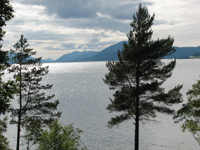
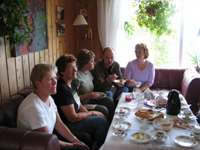
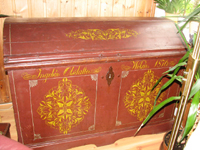
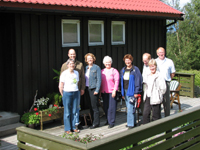
The View Lunch Ingeborg Vigen Chest Family
In the corner of the Sallaup living room is Ingeborg O. Wiken’s huge chest from 1876. A smaller one labeled Ingebor Vigen is next to it. (See how difficult genealogical research can be when names are spelled willy-nilly? Wiken, Wigen, Vigen, Viken!) We again passed around old pictures of family and heard stories of the two uncles – Gustave and Semund – who emigrated to America, but came back to visit on more than one occasion. Gustave had even built the old house up on the hill that has since been sold out of the family Sallaup.
Jørgen and Brit left earlier than the rest of us in order to make it back in time to milk cows. The sun was finally out in force as we walked over to Erling’s “second house,” which he and Astrid have been working on for years. We left regretfully as we were due back at Nerdal at 7:00pm. We took a different route home, driving along the west side of the Tingvoll and Sunndal fjords. We had just enough time and were only five minutes late to dinner.
Our last night with Brit’s family was spent at the big house where Jørgen and his family live. Elg (elk) that was killed by a hunting party at Nerdal is the main dish. Served with rice, broccoli, Brussels sprouts, tyttebær (Kamin’s favorite, he calls them “tootberries” or “cowbells”). We knew there’d be dessert later; we’d been fooled before! But we still ate second and third helpings.
The room was full of family antiques. Until Brit and Harald built their retirement house just a few yards from here, this is where they had lived and raised their children. Brit showed us the homemade wooden bowls her father made, antique painted furniture, chests, and toys. Marisa and Faye played the piano for a bit, but couldn’t convince anyone else to sit down.
Jørgen went to ready his slideshow in Øyastua, the eighteenth-century house on the place. It currently acts as a gift shop where Merethe displays some of her (and others’) homemade items. They were working on turning this into a B&B with a new bathroom, kitchen, and upstairs bedroom. With all the Innerdalen hikers on the road outside, this could be a great success. We sat down for cinnamon buns and cold pancakes served with strawberry jam and whipped cream. The show began. We were treated to slides of the family when the children were young, and of multiple trips that Jørgen and family have made to their seter (summer home) and the tops of the mountains and glaciers near Nerdal. Before we knew it, 11:00pm again.
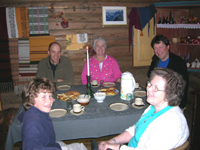
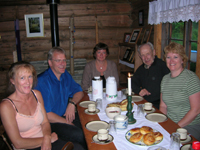
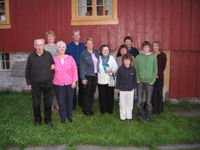
Dessert at Øyastua Family
With the sun out, it was brighter at this time of night than it had been earlier. We said our goodbyes outside, took several photographs, then headed back to Nybö for our last night in the Møre og Romsdal fylke. We had a wonderful time again with this family and all plan to return some day.
Thursday, June 29
We left Nybö at 8:45am in time to be at our next place: Fagernes in the district of Valdres in the Oppland fylke. We finally encountered completely sunny weather, so the drive through the Jotunheimen was good, though dizzying at times. We arrived in Fagernes about 2:30pm, met at the Valdres Folk Museum by our host, Ola Helge Fløene. He’s a distant relative (as many are in these isolated valleys), but our real connection with him is from emails a few years ago. He is really a local historian with superb English: what more could we ask for? We strolled through this open-air museum: a collection of old buildings brought to this site from all over Valdres in a typically Scandinavian preservation scheme.
Our real tour began at 4:00pm when we all piled into the car. First, we arrived where our farfarmorfarfar, Ole Tidemandsen Ranum, tried in vain to have a cemetery approved by the authorities down in Oslo. It’s a long story, involving his walking all the way, only to discover he didn’t have enough money to pay the fee for such an approval. We were near the farm of the Kulturstads, also ancestors. Throughout this stay in Valdres, we referred to our common ancestors, namely: Arne Klevgaard and Gunhild Breie who married and had four children who lived to adulthood and had children. This original Klevgaard couple are the common ancestors of all the family we met here.
Next we took off to see the Knut Revling farm, home to the closest relations we have still living in this valley, says Ola Helge. We entered the yard without warning and discovered two men sitting outside at a table. Ola Helge explained our presence, and, after only a few minutes, Knut walked over to the car to invite us out. Dressed in khaki shorts and a Valdres Golf shirt, he looked, for all the world, like someone from the southern U.S. Offering a bottle of Premier Cru chardonnay, all but Kamin accepted. (There is a 0% tolerance for drinking and driving in Norway, so it’s simply not done.)
Under soft, blue summer skies, we had a toast to family, in the shadow of the newly-painted barn. Knut is a co-owner of a management consulting company based in Zurich who travels around the world and speaks English well. Soon, Knut’s wife, Anna, returns. An English, French, and German teacher at the local high school, she gave us a tour through their stunning home, built in 1860 around the much older eighteenth-century fireplace.
After an exchange of email addresses, we left and discovered that it was already 7:30pm. How could one tell if one has outstayed a welcome when the sun never sets? We drove down through the new golf course, across the river to the other side of the valley. The scenery is breathtaking, at times resembling nothing less than a fake painted backdrop or postcard.
We stopped at the Aurdal Kirke (church), then drove up to the Fagernes Airport (with only a few flights in and out each day, Ola Helge calls it the “Place of Heavenly Peace”). We passed by the Ranum farm, home to yet more family, and on through the winding, back roads. Ola Helge regaled us with stories about local history and we heard of the hard times families had before emigrating. As he said, “Once the family had to sell their last cow, they had only the kittens to sell and that’s not a very good business!”
At nearly 10:00pm, we finished. After stopping at a Mini Pris for a few groceries, we joined Ole Helga for dinner at his house. We ate hot rice porridge (another taste from our youth in northern Minnesota) and left an hour later to bunk in at his guest house. This was a very long day, but enlightening, amusing, and just plain fun.
Friday, June 30
We met Ola Helge at 11:00am to drive to the small town center of Bruflat. In the narrow Etnedal valley, it was the last administrative unit to be designated as a kommune in Valdres. We met Tidemann Kolsrud there, a distant cousin. We also learned that his first name is quite unusual for Norway and possibly found only in this area. He’s in his early sixties, tall and lean; when he and Kamin stood next to each other, we couldn’t help thinking about physical similarities between the Scandinavian “originals” and their descendants (our father and his brother, Bill) who surrounded all of us in our immigrant hometown in Minnesota.
Tidemann was joined by Per Odd Smelhus and Ole Lunde, two more of our distant relations from our Klevgaard great-grandmother. Strangely, we already knew Per Odd as a relative through marriage on the other side of our family. Ola Helge had detailed all of these connections in a very helpful graphical handout that he presented. He described these family connections not as a tree, but more of a slalom: back and forth through the years with men and women “jumping the fence” to marry the neighbor, who was, quite likely, a third or fourth cousin.We entered the Bruflat Kirke, moved to this site in 1774. We marveled at the beautiful carvings and traditional rosemaling (flower painting) on the woodwork.
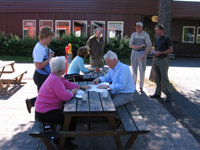
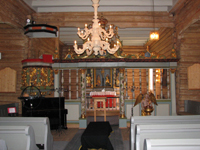
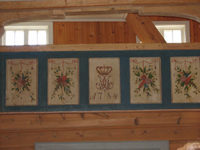
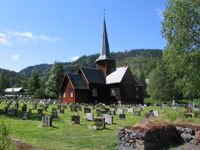
Family Bruflat Kirke
We again exchanged old photographs and family histories, then said goodbye to Tidemann before journeying to Ole Lunde’s farm for coffee. His was once one of the largest farms in the valley, though it has been split into smaller farms over the centuries. We sat under the trees on the spacious lawn and talked––over coffee and cake––about family histories and stories. It soon evolved (devolved?!) into a lively conversation about both Norwegian and American politics. Ole Lunde’s son was visiting, home from his studies in a Hungarian medical school. Nearly all of his classes there are in English, so he was also a great asset to our conversations as he dropped by the table occasionally. On this working farm, though, there were still chores to be done and he didn’t stay long. At Per Odd’s encouragement, we were led through the Lunde’s dining room: locally famous for its traditional Valdres furnishings.
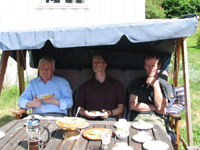
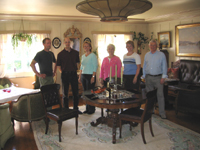
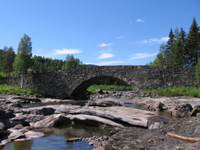
Per Odd, Kamin, and Ole Family Lunde Bru
Our time to leave had come again, and we drove over the Lunde Bru which is famous in the region. (In fact, this district known as Bruflat simply means the “flat place near the bridge.”) We worked our way up the mountainside to the northern Klevgaard farm. A house from the 1860s still stands, probably built by the great grandfather of the old widower who now lived there alone. No relation to us, he nonetheless allowed us to walk the place and take pictures of the buildings. We visited the southern Klevgaard farm, then drove around the valley, down to the town of Bagn, a site of fierce German fighting in April 1940. We finished up our two-day tour at the exquisite Reinli stavkirk.
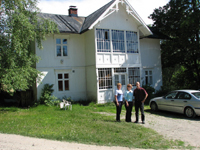
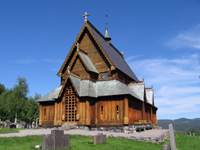
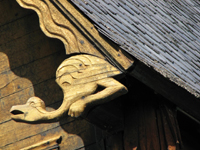
Damita, Marisa, Kamin:
northern Klevgaard farmReinli Stavkirk
It had been a jam-packed visit, and we said goodbye to Ola Helge around 6:00pm. After a relaxing dinner, we prepared for a fourth family place to come on the next day.
Saturday, July 1
After great night’s sleep in a hotel (not cheap), we gorged on a buffet breakfast that started the day at 6:45am: pickled herring, cucumbers, tomatoes, scrambled and hard boiled eggs, sausages, potatoes, all kinds of cheese, pickles, salads, flatbread – the works.
We were off, then, for our 11:00am appointment with the Øverbys near Veggli. We drove through acres of spruce as we left Fagernes and were reminded that Ola Helge spoke of several old tuberculosis sanitariums in the area; it was thought that spruce-filled air was good for the patients.
We drove on through the Hallingdal and then to our stopping place in the Numedal valley where our morfarfar, Ole Torkelson, was born one hundred and forty years ago. After a final cell phone call for directions, we arrived at Pontedalen––a small piece of land for tenants back then, but part of the larger Lofthus farm. As when Faye and her siblings visited in 2004, one could see where the small––tiny––house used to be, where Ole, his parents, and seven others lived before emigrating.
Nearby stands a hundred-year-old house, beautifully restored. The Øverbys now use this as their summer place, and we all sat down to a giant lunch of open-faced sandwiches, including a darker geitost (goat cheese), a speciality of this area. A dessert of cake and vanilla ice cream rounded out this unexpected treat. Our table talk was about history and current politics, and we enjoyed exchanging both Norwegian and English words with ten-year-old Maren.
Kamin admired a motorcycle outside, and we learned that Birger’s daughter and her husband would soon take a long ride with a tour group on Route 66 in the U.S., starting from Chicago in July, landing several days later in Los Angeles. We empathize with the shape they’ll be in after this arduous and steamy trip. One of the other members at the table described how they’ll look after a day of riding: “monkey butt,” he said with a grin. We dissolved into laughter, picturing the way monkeys (and motorcycle-riders) walk.
When our laughter subsided, we were ready to share more of our actual family history, that which was handed down to us on the other side of the ocean. We gave them a hard-cover copy of our grandfather Melvin Torkelson’s book Life on the Fraction. (Melvin was the oldest son of Ole Torkelson, born on the place.) We also left a copy of the DVD made last year detailing the family history of Ole Torkelson, his wife, and their nine children.
We then drove up the hill as close as possible to the remains of the Saelebote farm, where Torkel Anfinson (Ole’s father) was born. After leaving the cars, we took an enjoyable hike through the woods. The trail is nearly non-existent, and we meandered through the woods with Kamin and Birger in the lead, trying to puzzle out just exactly where the ruins are. Soon, we stood in the clearing next to the old well and the cowshed. (A picture from the Rollag Buskerud Bygdebok shows a picture of Saelebote as it was over one hundred years ago, as emigrants got ready to leave; we snapped a picture of ourselves from that same vantage point.)
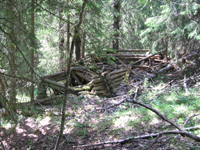
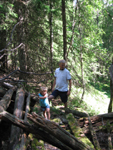
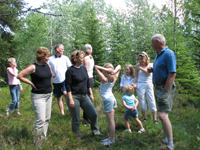
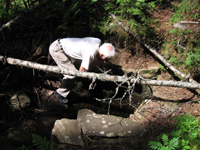
Saelebote Barn Ruins Marisa's Norwegian Lesson Sweet Water from the Old Well
The stroll back through the woods on this sunny warm day was too short. Two of Birger’s granddaughters––Kristine and Maren ––regaled Marisa with new Norwegian words and phrases. (Anybody who wanted to learn Norwegian could spend just three months with these two girls and become fluent – they are excellent teachers!) Unfortunately, Marisa couldn’t roll her R’s like them, so there were giggles all around.
We said our farewells at the cars, after exchanging email addresses. We had spent a surprisingly short three hours with this lovely family. Undoubtedly, each of us would have gladly walked another few miles through the woods, just to spend more time with these generous people. How kind of them to have driven up from Kongsburg and the Oslo suburbs to spend time with us and show us our old family places.
Time then came for us to drive on to our final destination this day: the district of Toten. It took us three hours to loop down the valley, almost to Oslo, then back up another valley to reach this area where we would end our travels to family home places. We arrived at Holthe Gård, a B&B near Kolbu, at about 6:30pm. On this glorious early evening in Norway the farm was beautiful, and our accommodations bordered on the luxurious as we were all alone in the freshly painted guesthouse.
We took our picnic goodies to the kitchen and made more plans for relaxation that evening. We ate small snacks for supper (we’d been eating constantly) followed by walks in the countryside. Having bought English-language books at various train stations or airport stores in the past several days, each of us eventually finished the evening by reading in bed (in the refracted midnight sun, without reading lamps) before falling asleep before 1:00am.
Sunday, July 2
Having had the windows open all night, we awakened to the sounds of roosters crowing in the early morning. Breakfast was at 8:00am and we all headed to the big house a few minutes early. Linda, the proprietress, speaks English fluently, so we conversed a little bit until she needed to leave and look after her two small children.
We left for the first of three family site visits this day, our last chance for such activity. We drove first to Seglestad Bru at the northern end of the Gausdal valley. Birthplace of the Stene family (our morfarmor’s family), there was no one here that we know of, even a distant cousin. Two years before, Faye and her siblings spent the afternoon with Ivar Steine, who owns the very large farm, of which our great grandmother’s family had only a small piece as a tenant farm. We stopped to take pictures of the place in the valley where the farm used to be, then drove on to the Follebu Kirke. Likely, this is where the old family members were baptized and confirmed, but there were no headstones to mark any relations that we know of.
Back down the valley we met up with Turid Øystaas who works in the Toten Museum. She had very graciously made up copies of detailed maps and some family records for our last two stops this day. Marisa had exchanged emails with her earlier, so she met us just outside Gjøvik late this Sunday morning. We promised information about American descendents of these families in exchange for her Norwegian research, though no such promise was required. It turned out that the museum was working on just this sort of project: tracking the emigrants from Toten and researching information about the descendents of those families in the U.S.
Thanking her for the maps, which will be especially useful, we headed up to Vardal, just a small cluster of buildings and a church several miles north of Gjøvik. Our farfarfar’s family––the Johnsons (Johannesens)––left from here in the mid 1860s.
Their small farms of Lille Gryte and Nedre Gryte are gone, as far as we can tell, and there’s no map record of Føllingstad – the farm they last lived on before emigrating. We drove on the roads marked out by Turid and took pictures of the landscape, remembering for our own records, at least, the area once walked by our family before they left Norway. We stopped at the Vardal Kirke as well, a beautiful white wooden building that was built in 1802 and would have been familiar to our ancestors.
After an unexpectedly good lunch at an Italian restaurant in Raufoss (the only town of size where we can find something open on Sunday), we moved to the final family spot of this trip. Faye had already been to the Røsedahl farm where our mormormor (Karoline) was born, but today we would try to get to the birthplace of Karoline’s mother – the Nedre Kvikstad farm. We stopped at the Kolbu Kirke first, the home church of this family. We took several pictures of various Kvikstad gravestones; perhaps these would come in handy for later research.
A few people we met in the churchyard told Faye that they knew where Nedre Kvikstad is now, but concurred with Turid’s previous advice: the farm land has been sold off to another family and the few acres around the house are owned by yet another family. After dropping Marisa off back at Holthe Gård, the others continued to explore this Kvikstad connection. Upon driving into the yard of what is left of the Nedre Kvikstad place, they had a lively conversation, lasting two hours, with the people there. Indeed, they were no relation to our family, but the older woman was eager to speak to descendents of emigrants who left there.
Back at the gjesthus (guest house), supper consisted of finishing up all of our picnic food from the trip: cheese, sardines, fresh and sweet norsk jordbær (strawberries), and Kamin’s old trail mix from the Newark airport. It’s an odd, and not completely satisfying, meal.
Faye and Damita went to the main house at 8:30pm to watch, with the local family, the DVD made from photographs of the last trip Faye made to Norway in 2004. (Meanwhile, Marisa and Kamin watched very bad American television again. How is it that we export the worst of Nickelodeon and Fox to foreign countries? Surely there is something more broadly representative of reasonable American culture.).
Monday, July 3
We packed the car before breakfast at 8:00am, lingering over the tasty bread, cheese, meats, and coffee. Kamin, still a big fan of the Norwegian berry preserves, has more than one helping. We managed to find a gas station to fill up our Ford Focus station wagon, then turned it in at the Oslo airport.
Kamin was an excellent driver of our manual-transmission, diesel-powered car. There were only a few breaks where Marisa took the wheel; the rest of the time he sat calmly in the driver’s seat going over hairpin curves on gravel roads, bumping over construction debris, and even driving up through the tall grass in Fagernes.
At Oslo Gardemoen we caught the Flybuss – a 45-minute ride into Oslo that dropped us off only a five-minute walk away from the Coch’s Pensjonat at the northern end of the Slottsparken (the Royal Palace park). We were happy with this place after checking in: great location, good price, clean and appealing.
We left our stuff in the baggage room and walked through the park, arriving at the palace right at noon to watch the changing of the guard. More strolling in the tree-lined sidewalks along Karl Johans gate, down toward the train station. We took a left at the cathedral to walk over to Grunerløkka, a newly-gentrified area of the city. The shops were interesting, but we weren’t really in the mood for this young, “hip” place, so we stopped in an outdoor restaurant for a bite to eat. We were in Oslo––the most expensive city in Europe, all right. Faye treated the group to lunch, shelling out nearly $100 for a large pizza, one salad, and drinks.
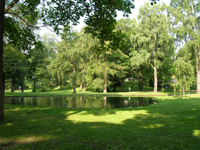
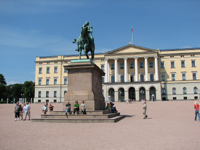
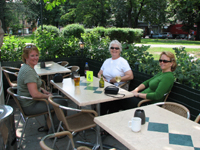
SlottsPark Royal Palace Lunch
The hotel was a twenty-minute walk away, so we went back to rest up for just a few minutes with a smoothie and a coffee at a corner restaurant. Since this was Kamin’s last day in Norway, we felt compelled to work overtime, to see more on this first day. We headed in the other direction to Frogner Park to view the Vigeland sculptures, under nice weather being enjoyed by people everywhere – sunning on the lawns, swimming in the pool – tour groups from France and Japan being lectured about the park’s significant works of art. We strolled among the bronzes and the granites, then headed back.

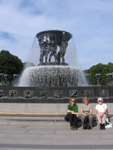
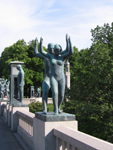

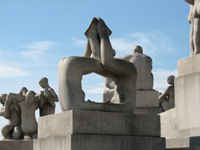
Frogner Park
One more hike took us back down Karl Johans gate and to the Akerbrygge at the harbor. The food is silly expensive along the water, but we hadn’t planned on stopping anyway. When Marisa was in school in Oslo in 1982, this was still an industrial wharf area, so it was lovely for her to see the changes.
We made it back at the hotel at 8:00pm. Even though we felt like well-seasoned travelers, the long day of walking had taken its toll. We had but a few snacks for supper from the local Mini Pris and set the alarm clock for Kamin’s early departure.
Tuesday, July 4
Kamin was gone early and Marisa relaxed in her newly-single hotel room. This would be a slow day for the ladies who remained, catching up on a few things before beginning the work of tourism again. Damita and Marisa left about 9:00am to check email at the train station kiosks, do a little shopping for Damita’s children, and buy some groceries for lunch. Faye was at the corner coffee shop when they returned at 11:30am. After lunch, all went back to the hotel for a nap followed by a relaxing afternoon on our own.
This night we’d arranged to meet Per Odd Smelhus again. We gathered up our research and materials on the Kvikstads from Toten to show him, and met him at 7:00pm at Lorry – a nice outdoor restaurant on the corner just outside our hotel. We weren’t meeting for dinner, just drinks, but we managed to spend over two hours laughing and talking about family on both sides of the ocean and future plans for more trips and family research.
Per Odd had traveled many times with Milton Sorenson––who had died just about four years before. (From South Dakota, Milton was our mormor Helen’s first cousin, once removed, in other words: she was his mother’s first cousin. Milton and Per Odd were related through his Sorenson father, not his Quickstad (Kvikstad) mother.) Apparently, Milton and he had great times: we looked at several photographs and were regaled with hysterical stories of their travels.
Per Odd speaks English beautifully, is perfectly charming, and we all said we hope to see him again. He’d had a heart attack just a few months before, but was planning (with doctor’s approval) his twenty-fifth trip back to the U.S. in August. We said our farewells, and Per Odd drove back to his home just after 9:00pm. We stayed in the restaurant for a delicious dinner where Marisa finally got the fiskesuppe (fish soup, hey?) that she’s been pining for..
Wednesday, July 5
Museum day! We left on the Bygdøy ferry for the Museum Island (actually Museum Peninsula) where the major tourist attractions are. We split up to go at our own pace through the Viking Ship, Kon-Tiki, and Sjøforts (seafaring) museums. The day was a hot one – probably in the 90s – so the walking from one museum to another was slower than usual.
Marisa returned to the hotel by 3:00pm, but Faye and Damita hopped aboard the ubiquitous double-decker, hop-on/hop-off bus for a tour of Oslo. (These really are great deals: for just about $18, one can ride on this ticket for the next forty-eight hours.) They were on the last bus and returned to the hotel around 6:30pm. After another grocery store supper of cheese, meats, and fresh vegetables, we were each off to bed early.
Oslo is beautiful in midsummer, but much more crowded this time than Marisa had seen in her past stays in the autumn or winter months. Nighttime temperatures in the 70s made the lack of air-conditioning a bit of a problem for sleeping, but a nice set of earplugs and keeping the windows open made it reasonably comfortable. Down “south,” there in Oslo, there was a semblance of twilight by 1:00am, but the sky grew bright and blue again by 3:00am.
Thursday-Friday, July 6-7
On the last full day in Norway, all three women were back on the bus for another run around the city. One goal for the day was to spend our last Norwegian kroner, so off we went to the Husfliden to buy a couple of Norwegian handmade products. These are stores, present in most Norwegian cities, that sell traditional Norwegian handicrafts and, most importantly, stock the materials and seamstresses necessary to create the Norwegian folk costumes called bunads. Marisa decided to stroll around the city one last time, while Faye and Damita got something to eat before their English-language tour of the Royal Palace.
We made plans to share the last of the groceries for supper, then spent a few hours running back and forth between our two rooms commiserating about the lack of space in our luggage.We rose early for the walk down the street to where the Flybuss will pick us up, making it to the airport in plenty of time to do a little duty-free shopping before catching the l-o-n-g flight home.
As with every trip made far, far away, the feeling and the mood on the ride home reflect more of the physical challenge of what the traveler has endured than of the import of the experience. But, even then, right after the expedition had ended, the sense of accomplishment––of undeniable benefit––washed over us.
Now, back home with diaries, photographs and the opportunity to correspond with new-found, close and distant relatives, we can play over in our hearts and minds those days of discovery. Because of the kindness extended by our native Norwegian family members, we have a clearer understanding, deeper appreciation and broader knowledge of our origins than all the hand-me-down legends our American folk could provide.
We are lucky that we could make the trip, and we are blessed by the exposure to these kind and decent people who share our cultural and genetic heritage..